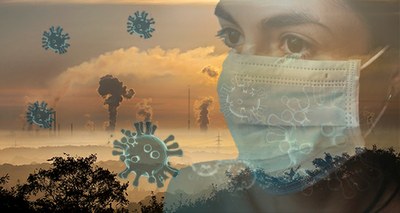Coronavirus: PULVIRUS project to detect the link between pollution and COVID-19
7/5/2020
An alliance to provide answers to institutions and citizens
 The launch of PULVIRUS, a joint research project among ENEA, the Istituto Superiore di Sanità (ISS) and the National System for Environmental Protection (SNPA, composed of ISPRA and the Regional Agencies of the National System for Environmental Protection) with the aim of providing institutions and citizens information, answers and indication on air pollution and COVID-19 based on scientific data, know-how and experience, was announced today.
The launch of PULVIRUS, a joint research project among ENEA, the Istituto Superiore di Sanità (ISS) and the National System for Environmental Protection (SNPA, composed of ISPRA and the Regional Agencies of the National System for Environmental Protection) with the aim of providing institutions and citizens information, answers and indication on air pollution and COVID-19 based on scientific data, know-how and experience, was announced today.
It’s a national initiative in coordination with the national pre-operational service "Air Quality - Mirror Copernicus" currently being defined and in close connection with the European project Life-Prepair on the Po Valley, which aims at pooling significant data sets, skills and ongoing experiences of the three institutions and verifying the tools that the scientific community can rely on to support environmental and health policies.
In particular the project wants to study in-depth:
- the controversial link between air pollution and the spread of the pandemic,
- the physical-chemical-biological interactions between fine particles and viruses
- the effects of the "lock down" on air pollution and greenhouse gases.
For the interaction study between atmospheric particulate matter and the virus, the project will employ both "in silico" analysis, i.e. the reproduction of the interaction between virus and atmospheric particulate by means of computer mathematical simulation, and a biological model representative of the characteristics of SARS-CoV- 2.
PULVIRUS will take place over a year, but in a few months some significant results will already be available, including a feasibility analysis of an early detection system to be activated possibly before next autumn. In addition, data, models and elaborations, reports and publications will be made available to the public and the national scientific community through a special website, constituting an extraordinary database for subsequent studies.
"What has occurred with the lockdown is an exceptional, hopefully unique event, and an involuntary and otherwise not feasible experiment of blocking emission sources, which can demonstrate the amplitude and intensity of the measures needed to comply with concentrations thresholds, and provide indications on how to deal with the so-called 'smog emergencies' that occur annually ", ENEA, the ISS and the SNPA explained.
Specifically, the Project is based on the evidence that the introduction of measures to combat COVID-19 has brought about a decrease in the concentrations of some atmospheric pollutants, as shown by air quality monitoring networks data.
The preliminary analysis indicates that the concentrations of pollutants do not follow the same trends, as it is inevitable for complex and non-linear phenomena. The decrease in the concentrations of some pollutants such as nitrogen dioxide (NO2) seems to affect the monitoring stations closer to vehicular traffic and less those far from the sources.
The fluctuating trends of the concentration of the particulate matter depend on the role that meteorological variability and chemical reactions in the atmosphere play in its formation and dispersion. The goal is therefore to conduct a serious and in-depth analysis on these issues, based on verifiable scientific protocols, so as to provide institutions and citizens with reliable information, useful for a better understanding of the phenomena and the appropriate decisions to be taken.
